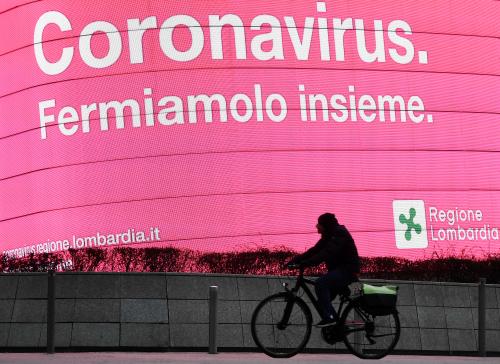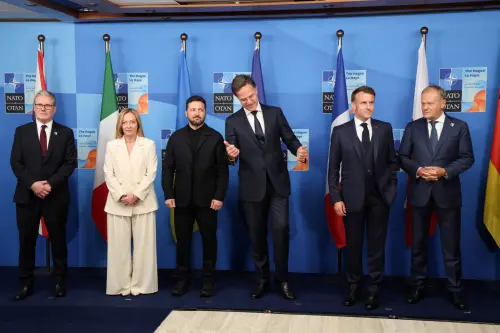The following is an excerpt from Reopening the World: How to Save Lives and Livelihoods, a new report where Brookings experts offer ideas to help policymakers protect lives and save livelihoods in the midst of the current COVID-19 pandemic.
 Nearly two months after Italian Prime Minister Giuseppe Conte imposed a national lockdown that restricted personal mobility to essential trips such as pharmacies and grocery stores, he announced a plan for reopening. Compared with the series of decrees that escalated coronavirus-related restrictions, the government’s reopening plan—called Phase 2 and starting from May 4—has created uncertainty about which activities are allowed and shifted responsibility for appropriate social distancing and behavior in public settings to individuals. Italy’s coronavirus experience has ignited political debate regarding coordination between states and regions, unhealthy political and economic pressure on the government, and clarity of communication.
Nearly two months after Italian Prime Minister Giuseppe Conte imposed a national lockdown that restricted personal mobility to essential trips such as pharmacies and grocery stores, he announced a plan for reopening. Compared with the series of decrees that escalated coronavirus-related restrictions, the government’s reopening plan—called Phase 2 and starting from May 4—has created uncertainty about which activities are allowed and shifted responsibility for appropriate social distancing and behavior in public settings to individuals. Italy’s coronavirus experience has ignited political debate regarding coordination between states and regions, unhealthy political and economic pressure on the government, and clarity of communication.
LIVING WITH THE VIRUS
The Phase 2 plan, also known as the “living with the virus phase,” is meant to reopen the country starting from the activities in the manufacturing sector, construction, real estate, and wholesale trade. Starting from May 4, Italians will be allowed to visit their relatives living in the same region or to return to their residence. Funeral ceremonies are the only religious services to be reinstated, with restrictions on the number of people allowed to attend. Retail sales are scheduled to restart on May 18, along with beauticians, hair salons, restaurants, and bars, although there will need to be a one-meter distance between tables.
Unlike in other European countries, such as Germany and France, Italian schools will remain closed until September. A rotating schedule of online and in-person classes will be instituted to keep a one-meter distance between students and to protect the teachers, whose average age is 50 years old.
Wearing face masks is mandatory for all these activities, as well as for riding public transportation. For this reason, the Italian government established a fixed price of €0.50 per mask and offered incentives for the purchase of bikes.
Many people have complained about the unclear phrasing of the decree, especially pertaining to the definition of “relatives.” The decree used the word congiunti, literally meaning “related,” which is not defined in the Italian civil code. Conte clarified later that relatives are “people with whom you have family relations. Or, stable emotional relations.” But aside this clarification, many doubts persisted around what is allowed or not and where, because of the discretionary power left to the regions in the application of such guidelines.
PROBLEMS OF COORDINATION, GOVERNANCE, AND COMMUNICATION
On the heels of a disastrous GDP forecast for 2020 (-9.1 percent according to the International Monetary Fund) combined with the emotional cost of keeping 60 million people at home for two months, reopening certain economic activities and lifting some of the strict restrictions are seen as economic and social necessities. But if Italy’s track record is any guide, there are at least three challenges ahead.
The first challenge is the coordination between the central government and the regional governments (which was already complicated before COVID-19), particularly with respect to healthcare and lockdown measures. Since the 2001 constitutional reform, regions have been entrusted with managing their own healthcare systems within the national framework, and this has created medical service disparities and competition between these levels. For example, Lombardy is known for its excellent healthcare facilities, especially for highly specialized procedures. However, in the past 10 years, this region has witnessed a surge of private clinics supported by public funds and a consequent shortage of public primary care providers, both in terms of physicians and facilities. As private clinics were not equipped with intensive care units, COVID-19 patients needed to be taken to hospitals where the contagion continued to spread, while some patients with symptoms were left alone in their homes, and medical personnel had trouble accessing testing. On the contrary, the Veneto region was able to offer better screening.
Therefore, many argue that centralized management of the National Healthcare System (Sistema sanitario nazionale) could have planned a more efficient use of budgetary resources and ensured better uniformity and coordination in the quality of healthcare, testing, and isolation procedures within regions and across the nation. When COVID-19 hit Italy, regional governors took different lockdown and screening measures (some stricter than others) without coordinating with neighboring regions and sometimes in open contradiction with the central government. Recently, for example, the governor of the Calabria region (which has a contagion rate of zero) reopened outside seating for bars and restaurants, a move that has been challenged by Minister for Regional Affairs Francesco Boccia in the Legal Council of State given fear that this decision could affect the spread of the infection. Uncoordinated differences of interpretation of reopening norms, especially as inter-regional travel resumes, risk overwhelming the regions with weaker healthcare facilities.
The second challenge is the unhealthy state of Italian politics. Matteo Salvini, the leader of the League (right wing nationalist party), who expressed conflicting views on domestic and international lockdown measures throughout the crisis, put pressure on Conte’s government and on Lombardy’s governor, Attilio Fontana (League), to reopen the economic activities in the region despite higher infection rates than any other Italian region, let alone the southern ones, where economic activities have paused regardless of a zero-infection rate. Former Prime Minister Matteo Renzi (Italia Viva) also pushed for reopening, threatening to withdraw support for Conte’s government in the Italian parliament.
More broadly, the hyper-politicization of the economic measures to be agreed with the European Union brought back a reinforced sovereigntist narrative from the League and Brothers of Italy (both on the far right of the political spectrum). Their confrontational approach toward the EU over the European Stability Mechanism and economic response to the crisis (and the spread of false information) are weakening Italy’s position at the negotiating table, as they are blaming the government of being politically and economically dependent on aid from Brussels and Berlin.
Without a more coordinated path for differentiated reopening among the Italian regions that puts public health realities ahead of political pressures, Italy risks experiencing an uncontrolled coronavirus resurgence and even greater economic damages.
The third challenge is political communication. In issuing the lockdown orders, Prime Minister 91 Conte relied on press conferences where he placed great emphasis on coordination with the National Institute of Health and provided clarity on the extent of the lockdown. Yet, for Phase 2, Conte’s press conference lacked sufficient detail on what was allowed as well as scientific explanations of the logic behind the reopening of nonessential activities and the lifting of major restrictions. While the contagion curve is declining, the number of new cases at the time of Conte’s speech was still very high (over 2,000 new cases detected). It is therefore unclear what conditions would allow for further relaxation of restrictions and what conditions would contribute to a second lockdown.
THE RISK OF AN UNCONTROLLED COVID-19 RESURGENCE
Indeed, healthcare facilities are no longer overwhelmed and are starting to operate at a more regular pace. However, as countries reopen and in the absence of a vaccine, an increase in the infection rate is most certainly expected and the main question is how to avoid a second peak and an economic collapse at the same time. Without a more coordinated path for differentiated reopening among the Italian regions that puts public health realities ahead of political pressures, Italy risks experiencing an uncontrolled coronavirus resurgence and even greater economic damages. Given the absence of clear communication from the government on the rationale for the reopening schedule, Italians will find it hard to accept and comply with the restrictions and those that might be reintroduced in the event of a second peak.
The Brookings Institution is committed to quality, independence, and impact.
We are supported by a diverse array of funders. In line with our values and policies, each Brookings publication represents the sole views of its author(s).









Commentary
Reopening the World: Italy’s reopening
June 16, 2020